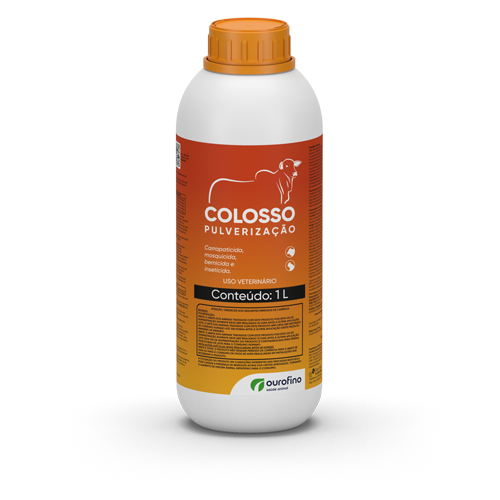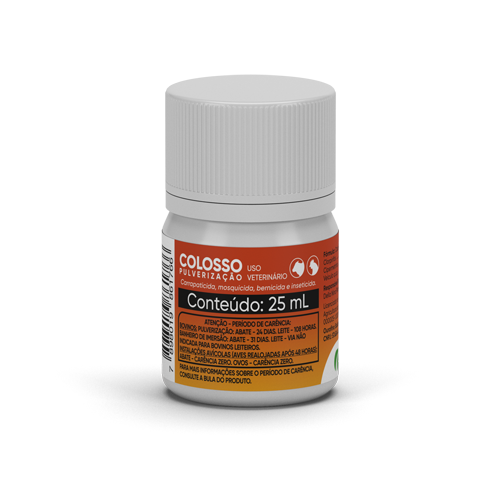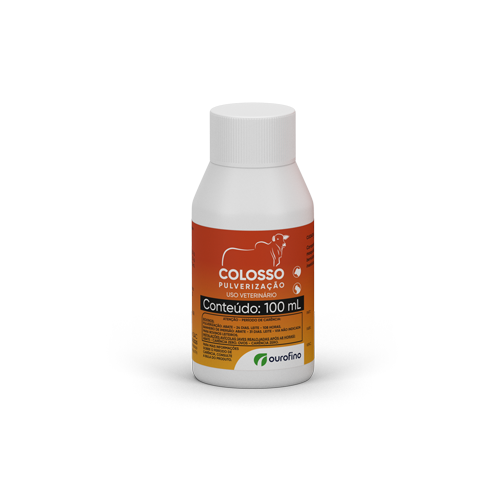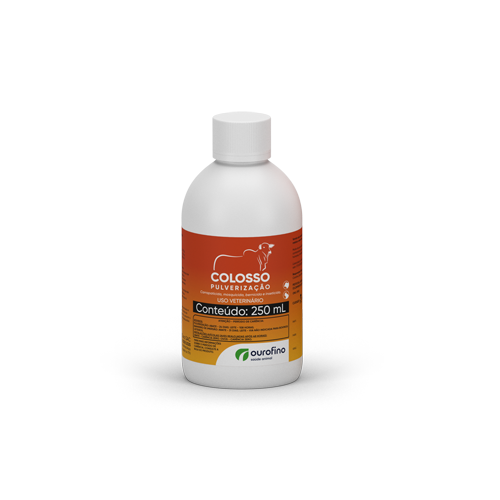Colosso Pulverização
Ectoparasiticide based on cypermethrin and chlorpyrifos.
EctoparasiticidesFórmula
Each 100 mL contains:
Chlorpyrifos ......... 25.0 g
Cypermethrin ......... 15.0 g
Vehicle q. s. p. ......... 100.0 mL
Indications:
COLOSSO PULVERIZAÇÃO is indicated for the strategic treatment and control of bovine dermatobiosis - berne (larvae of Dermatobia hominis), tick (Rhipicephalus Boophilus microplus) and in the control of the Horned fly (haematobia irritans).
Product safe for use in pregnant cows, administered by spraying.
COLOSSO PULVERIZAÇÃO is also indicated for the control of environmental infestations by adults and larvae of Alphitobius diaperinus (cascudinho) in poultry facilities intended for the production of broiler and laying birds.
Modo de uso e dosagem:
For cattle: dilute the COLOSSO PULVERIZAÇÃO a ratio of 1: 800.

Via spraying: the application must be done individually and with the animal contained. Use for application practical, comfortable equipment capable of enabling a bath with pressure strong enough for the solution to reach the animal's leather. The nozzle used must be fan-shaped and the application from top to bottom, in the opposite direction to the hair, and always downwind.
Homogenize the mixture / syrup and spray over the entire body of the animal including ears, chin, armpits, groin, tail insert and the entire lower part of the animal; leaving it completely wet, so that the product reaches even small ticks and in parts of the body where they are not easily seen. Use 4 to 5 liters of syrup per animal according to the body extension, that is, enough to wet the entire body of the animal. For calves, reduce the volume of syrup applied to 3.5 L / animal. After dilution, use the COLOSSO PULVERIZAÇÃO syrup within 24 hours. Via immersion bath: carry out a premix of the product with clean water in a bucket, stirring until complete homogenization.
Add this first solution obtained to the tank or immersion bath, partially filled with clean water and homogenize vigorously to obtain a homogeneous final solution and according to the indicated dilution. Do not add any stabilizers. Animals must pass through the toilet individually, so that the whole body is in full contact with the syrup. The soaking tank or toilet must be clean and free of debris. Whenever the solution remains stationary, homogenize again. Perform refills by analyzing the syrup. In a study conducted with COLOSSO PULVERIZAÇÃO, it was found that the concentrations of the active ingredients vary depending on the level of syrup in the immersion bathroom and during 12 months 3 (three) refills were required in a ratio of 1:800, which were performed due to the reduction of at least 10% of the syrup volume.
For poultry houses: apply the product via atomizer, with the possibility of use via spraying, in poultry houses, without the presence of birds. After removal of the birds, the aviary must be subjected to the usual cleaning and disinfection procedures prior to application of the product.

Via spraying: dilute the product in a ratio of 1:400 maintaining the recommendation of 1000 liters of syrup for 1,200 m2 of area.
Via atomization: dilute the product in a ratio of 1: 8. After dilution, apply the syrup throughout the aviary, so that, regardless of the route of application (spraying or atomization), 2.5 liters of COLOSSO PULVERIZAÇÃO are sufficient for spraying an aviary with 1,200 m2. After mixing until complete homogenization of the syrup, spray on the entire housing area of the birds, including walls, pillars, beams, sleepers, scissors, walls, Eaves, feed boxes, curtains and nests. When the litter is reused, open the litter to allow the product to reach the aviary floor. Do not spray the aviaries with the housed birds. It is indicated that the birds return to the shed after at least 48 hours of application of the product.
Generally, single-dose treatment is sufficient to reduce the parasitic load on animals and poultry facilities, however, the existing management practices on each property, as well as on farms, such as pasture rotation, facilities, animal density, sex, as well as genetic or racial characteristics, can influence the incidence of parasites and, consequently, the effectiveness of the product. Thus, each rural property may have different needs for parasite control, being recommended the integrated and strategic control of parasites, to be defined by the veterinarian.





